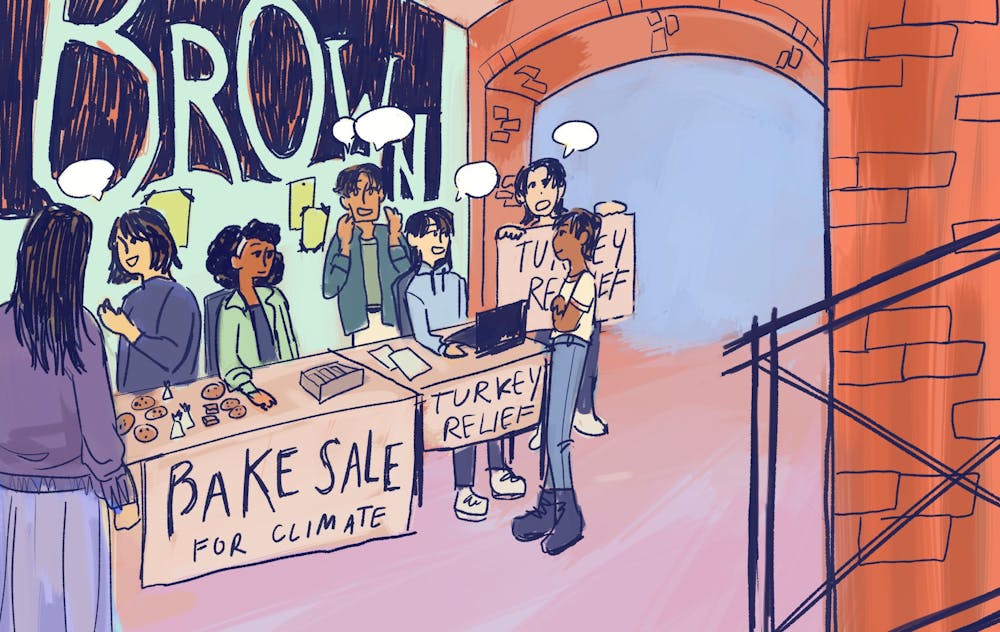When Umeed@Brown, a group that advocates for low-income cancer patients in developing countries, wanted to host a fundraiser event, they had to separately request event support from their Student Activities Office advisor and a donations link from SAO’s financial manager, which then additionally had to be approved by commerce managers. But before Umeed could have access to the donations link, their advisor also had to approve the event.
For Zain Peerbhoy ’24, Umeed fundraising chair, the fundraising process felt unnecessarily lengthy — delayed by a “fragmented” communications process.
Due to additional technical changes that needed to be made to the initial link when Umeed first received it, the group ultimately had to wait ten days after their request before they were able to receive their first payment, Peerbhoy said.
According to Joie Steele, senior associate dean and director of student activities, SAO’s goal “is to make these processes easy for student to engage with while also emphasizing the importance of early planning and looping SAO in as soon as possible.” Steele emphasized SAO staff’s willingness to talk one-on-one with student groups about their experiences and potential improvements for the future.
Umeed is not the only campus group to encounter difficulties trying to fundraise. When members of the Brown Cultural Association of Turkey fundraised for earthquake relief in Turkey and Syria, they could not use Venmo to collect donations.
According to CAT Secretary Alara Kalfazade ’24, the group initially wanted to donate their student group funding directly to earthquake relief but were told by SAO that they couldn’t do so.
The Undergraduate Finance Board “generally does not allocate funds to be donated to external nonprofits, because the (Student Activities) Fund is, by IRS and other legal restrictions, to be used only in accordance with the language of the Student Activities fee — as set by the Corporation,” wrote UFB Vice Chair Arjun Krishna Chopra ’25 in an email to The Herald.
Fundraising on campus — for both student groups and external organizations — is a complicated process, according to several students that spoke with The Herald.
Fundraising for internal vs. external causes
According to Steele, the University’s fundraising policies differ for student groups raising money for their own operations and student groups fundraising for an external organization. When student groups fundraise for internal purposes, they are essentially “fundraising for Brown,” Steele said.
“Everything (Brown student organizations) do is on behalf of Brown,” she added.
Groups wishing to fundraise internally can collect cash on-site and bring it to SAO to have the money deposited into their student group account, Steele said. Groups can request cash boxes as well as petty cash change from SAO.
For electronic donations, groups need to set up a webpage through the Advancement Leadership Team in the University's Division of Advancement, according to Steele. The division aims to “build relationships that engage Brown’s worldwide community … and inspire them to give back to Brown through philanthropy and volunteerism,” according to the University’s website.
All electronic payments for external fundraising have to be made through a requested Brown Marketplace page, a secure “approved portal for any online sales that groups want to do,” Steele said. “That money goes into their student account, and then we will make the payment for them directly to whatever external organization that they request us to send it to.”
According to Steele, Brown Marketplace has been “utilized for many years (for groups) to sell things” and has been updated “in the past couple of years” to accommodate student desire to take online payments and “make donations to external organizations.”
External cash donations are handled the same way as when groups fundraise internally, Steele said. SAO deposits the cash into the student group’s account and then makes payments to the desired external organization.
Balancing security and convenience
Brown Marketplace requires that all donors input their credit card information. According to Peerbhoy, this is one of the service’s largest deterrents.
Peerbhoy, who is also a community service chair for the South Asian Students’ Association, said that when SASA wants to host ticketed performances, many people agree to buy tickets but “never fill out the rest of the (payment) form” because they find the process too lengthy.
“Then you won’t get the money … even though those people actually wanted to donate,” he said. “I would say we could easily double our fundraising if we were able to use Venmo.”
“Venmo, in the nature of a consumer to business (scenario), doesn’t work like the Venmo relationship in a peer-to-peer” payment, said Wynette Zuppardi, senior director of University Receivables and Commerce. “The University has policies on accepting any sort of payment … and Venmo falls (into) the same policies as credit card payments.”
“Our card payment processor that’s connected to (Brown) Marketplace doesn’t have a relationship (with Venmo) to accept Venmo as a payment method,” she said.
According to Zuppardi, another reason for not accepting Venmo is to “protect individuals on campus from accepting payment on behalf of the University” due to “potential tax implications.”
“If there’s collection of payment above a certain amount, then there’s a potential requirement that the individual would have to report that as … taxable income on their tax return,” she said.
“We vet certain vendors in order to make sure that … it is secure before we allow it to be used on behalf of the University,” she said. She emphasized that “one of the key reasons” for these policies “is to protect a cardholder.”
“I totally understand that (Brown Marketplace) takes a little bit longer,” Steele said. “But it is one of the ways (to) ensure that people’s information is safe and protected.”
Steele said that the peer institutions SAO has been in contact with — Columbia, Princeton and the University of Chicago — each manage Venmo in the same way as Brown.
According to Zuppardi, the University is currently working on “a relationship” with one of the University’s “card payment processors in order to accept Venmo as an in-person transaction.”
“For the person collecting the payment, they would (need) a device approved and provided by Financial Services … to use in order to collect a payment via Venmo,” she said.
“We are trying to balance the needs of the campus, but then also the compliance regulations and the security” of payments, Zuppardi said.
Narrow donation options
The University requires that student groups only donate to 501(c)(3) organizations when sending money to external organizations, according to Charlene Sweeney, associate vice president and University controller. These organizations are “commonly referred to as charitable organizations” that are “eligible to receive tax-deductible contributions,” according to the Internal Revenue Service’s website.
According to Peerbhoy, Umeed has struggled with finding “international (nonprofit) organizations that are 501(c)(3) compliant.”
“It narrows down our options,” Peerbhoy said, though he added that both Umeed and SASA have been able to adapt and work around the restriction’s challenges.
Kalfazade felt that the University staff CAT worked with throughout their fundraising for earthquake relief “didn’t know what to do in an emergency” and brought little prior experience dealing with urgent fundraisers for life-threatening disasters.
“When things happen that need immediate response on a short timeline, we will absolutely make the time for meeting (with students) to talk through plans,” Steele said. “We’ll help with connecting to other campus resources and help navigate some of those requirements around ten days’ notice.”
“We’re trying really hard (when) students can’t do something within Brown policy to really work with them to think creatively and come up with solutions,” Steele added.

Kathy Wang was the senior editor of community of The Brown Daily Herald's 134th Editorial Board. She previously covered student government and international student life as a University News editor. When she's not at The Herald, you can find her watching cooking videos or writing creative nonfiction.





